
|
||||||
|
THE GOLDEN ROSARY OF THE KAGYU Reviewing the lives of our lineage ancestors, by Karmapa IX Wangchuk Dorje possessed the same powers as his predecessor. When Phuntsog Namgyal, the King of Sikkim, made a pilgrimage incognito to Karmapa's monastery, he was, to his surprise, greeted by an advance party of monks. The Karmapa had foreseen his arrival. So impressed was the King that he offered to build several Kagyu monasteries for Karmapa in Sikkim. One of these was located in Rumtek, the site of Karmapa's present-day monastery in exile. Though the Karmapa could not be present for the consecration of one of these monasteries, Ralung, three large eagles took his place, clearly arriving from the direction of Tibet, circumambulating the monastery, and showering its roof with consecrated grains. In strengthening the ties between Sikkim and Tibet, Wangchuk Dorje was laying the groundwork for eventually being invited to Sikkim permanently during his sixteenth incarnation, when he was forced to flee Tibet. The ninth Karmapa passed away in 1603. Karmapa X The life of Choying Dorje » (1604-1674) is a study in the ability of a highly realized practitioner to retain self-mastery in the face of adversity. Modern-day practitioners sometimes underestimate the extent of the challenges great beings face, given that they are surrounded by near-constant adulation and an entourage trained to cater to their every physical need. But adversities there are -- and sometimes severe ones. Choying Dorje had a double dose, for his trials were both personal and political. To start, the chieftain of the Golok region where Karmapa was born decided, for reasons of greed, to assume control over Karmapa and his family under the guise of friendly "protection." By taking over arrangements for Karmapa's speaking tours he was able to pocket the majority of the offerings for himself -- and even went so far as to try driving a wedge between Choying Dorje and his family to increase the child's dependence on him. Karmapa also had difficulty receiving necessary teachings from his principal guide, the sixth Shamarpa. It was not until he reached his teens that he could break free. Some time later, the Mongolian, Gushri Khan, invaded Tibet and named the Fifth Dalai Lama temporal and spiritual leader of that land. This created a problem for the Kagyus because the Dalai and the Lhasa nobles by whom he was surrounded were all Gelukpas, and at odds with all Kagyu leaders, particularly those in Tibet's western province, Tsang. Backed by the superior force of the Mongols, the Dalai and his entourage eventually prevailed, in the process engaging in such sectarian violence as destroying Kagyu monasteries (including Tsurphu) and injuring and even killing Kagyu monks. Under the circumstances, Karmapa had no choice but to flee. He settled in the present-day province of Yunnan in China, staying there almost thirty years. Doubtless comforting to him during these troubled decades was his ability to exercise his several talents, which included poetry writing, painting, and sculpture. Indeed, so prominent a place did these arts hold in his life that he remarked, "On the art of poetry and painting, I can say I am one of the best in Tibet and its nearby regions. I came into this world to paint stories of the Buddhas, bodhisattvas, and arhats." Many of Choying Dorje's works survive to this day and are sometimes the focus of Asian art exhibitions. Karmapa was eventually invited by the Fifth Dalai Lama to return to his homeland. There, he and the Dalai Lama met, showing each other mutual respect in keeping with their status as bodhisattvas. Karmapa then went, at the Dalai's request, to perform rituals in the Lhasa suburb of Drag, where he proceeded to catch the flu. He died not long after, having gracefully traversed a tumultuous time in Tibet's history, and having left behind a number of inspired art works. Eleventh and Twelfth Karmapas Both the eleventh and twelfth Karmapas were short-lived, hence left modest legacies. The eleventh, Yeshe Dorje, lived 26 years, and was mostly known as a meditator and visionary possessed of healing powers. The twelfth, Jangchub Dorje, passed through another time of turbulence in Tibet (early 18th century), when the land was overrun by warring Mongol factions which again pillaged and destroyed non-Geluk monasteries. In consequence, Karmapa deemed it best to escape immediate danger by going on extensive pilgrimages in India, Nepal, and China. When he reached Lanzhou, he succumbed to a smallpox epidemic that was ravaging the area. Jangchub Dorje passed away in 1732. Karmapa XIII Relations between the central, Geluk-run government and the Kagyus remained rocky during the life of Dudul Dorje, although the latter eased the tensions between himself and the Gelukpa rulers by performing an exceptionally helpful miracle: when floodwaters rose in Lhasa to the point where they threatened the famed Jowo statue in the Jokhang (central cathedral), Karmapa wrote a letter to the king of the Nagas (underwater serpentine spirits), telling them to emulate the compassion of Avalokiteshvara. At his instruction, the letter was placed on the water, and immediately the flood started receding. Later, this Karmapa went to the Jokhang and presented an honorific scarf (khatag) to the Jowo statue, at which the statue moved its arms into the receiving position where they remain to this day. Dudul Dorje passed away in 1797. Karmapa XIV Thekchog Dorje was born in 1798. Owing to the efforts of the eighth Drukpa Lama, the sectarianism which had previously splintered the nation was largely pacified, giving way to a movement known as rime (non-sectarianism) in which the XIV Karmapa figured prominently. This brought him into close touch with three other highly realized contemporaries and promoters of philosophical unity: Jamyang Khyentse Wangpo,Jamgon Kongtrul, and the treasure-revealer, Chokgyur Lingpa. From the latter the Karmapa received the transmission of ceremonial Lama dances which Guru Padmasambhava had revealed to Chokgyur Lingpa in a vision. These dances continue to be performed by present-day Tibetan monks in exile. Karmapa was an adept of Anutara Yoga Tantra practices, and as such took consorts with whom he accomplished the union of bliss and emptiness. He passed away in 1868. Karmapa XV Khakhyab Dorje », who would ultimately be recognized as the XV Karmapa, was born beneath a canopy of rainbows in 1871. He became an ardent scholar -- masterful in medicine, art, and linguistics. He also possessed many siddhis (miracle powers), and was seen to pass through solid rock. Karmapa was additionally a terton -- a treasure revealer. Because female energy is thought to be essential in the finding of termas, Karmapa was encouraged to take a consort, though this generally went counter to the tradition of his line. Eventually, he had five consorts, one of whom became the mother of the second Jamgon Kongtrul. Thus, Karmapa fulfilled his function as treasure revealer, though in fact many times -- and contrary to convention -- treasures appeared mysteriously in his quarters, rather than having to be sought. In the end, he accumulated forty boxes of sacred statues and meteorite daggers which were brought by terma guardians directly to his shrine table. In his later years the Karmapa fell very ill and was again urged to take a consort to prolong life. The woman chosen, Urgyen Tsomo, was considered an embodied dakini and a very advanced practitioner -- so much so that the monks of Tsurphu accorded her the same respect as they would a Lama, something that was very rare in that time and place. Long after the death of the XV Karmapa, the Great Dakini of Tsurphu, as she was known, fled occupied Tibet with the XVI Karmapa, ultimately passing away in Sikkim. Her reincarnate was born to the Mindroling hierarch, and as Khandro Rinpoche is today teaching around the world. XVI Karmapa Born into a noble family in 1923, Rangjung Rigpe Dorje » manifested miracles even before his birth, having been heard reciting the OM MANI mantra while in his mother's womb. When he appeared before the Thirteenth Dalai Lama for the official hair-cutting ceremony that signals entry into monasticism, the Great Thirteenth asked him why, contrary to tradition, he was keeping his hat on. As it turned out, Karmapa had indeed removed the unadorned black hat known as the Activity Crown, but the mystic vajra crown bestowed by the dakinis remained floating above his head. Because of his pure vision, the Dalai Lama was able to see it. There were many other ways in which the Karmapa demonstrated his extraordinary spiritual stature, as when he one day danced delightedly, even while covered with snakes who had emerged from a hot spring, or when he threw an earthenware teapot from a window three stories above ground, retrieved it unharmed, and proceeded to squeeze the neck shut as if the object were made of dough. "It's only natural," he remarked when asked about this phenomenon. But in a more down-to-earth sense -- and particularly after fleeing occupied Tibet -- Karmapa made significant contributions to the strengthening and spread of the Dharma:he built a monastery in Sikkim just up the road from the one built by his ninth incarnation, housing there some priceless relics with which his party had escaped, among them an image of Padmasambhava which that master had made himself, a thangka made by Atisha, and the hammer used by Milarepa in the building of Marpa's towers; Karmapa also sponsored the printing of all the Buddha's teachings (Kangyur) and accompanying commentaries (Tengyur), amounting to over three hundred volumes, and had them distributed to numerous Dharma centers. In accordance with tradition, Karmapa oversaw the education of his four young regents: Shamar Rinpoche; Tai Situ Rinpoche; Jamgon Kongtrul; and Gyaltsap Rinpoche. Here,to complete our understanding of the relative positions of our own linege masters, we should mention that one of Karmapa's close students was Kalu Rinpoche », whom he recognized as an incarnation of Jamgon Kongtrul the Great. Eventually, Karmapa entrusted Kalu Rinpoche with the running of Jangchub Ling, a monastery in eastern Bhutan. It was during their early years of exile that Lama Norlha », spiritual head of Kagyu Drupgyu Chodzong, formed a close connection with Kalu Rinpoche, and it was through the combined requests of both Karmapa and Kalu Rinpoche that Lama Norlha assumed directorship of Kalu Rinpoche's American centers. Some time later, Lama Norlha founded his own Kagyu Thubten Choling in upstate NY, with subsequent branch centers, including Kagyu DC. In 1974 Ranjung Rigpe Dorje became the first Karmapa ever to journey to the West, where his many Vajra Crown ceremonies and his visits to Trungpa and Kalu Rinpoche's centers were crucial in helping Tibetan Dharma imprint itself on the American consciousness. Not only did he found Karma Triyana Dharmachakra monastery in Woodstock, NY, but under his guidance his four regents also established centers throughout Europe and America. In the 1970's Karmapa was stricken with stomach cancer, despite which he continued to travel and teach widely. During his final illness in 1981 he retained a miraculous presence and equanimity which confounded even his physicians. Not only did he manifest concern only for the feelings of others despite what is conventionally acknowledged as a painful disease, but after his passing (auspiciously for this country his consciousness parted from his body in a suburb of Chicago), his heart area remained warm for 3 days. After a grand cremation ceremony in Sikkim, Karmapa's heart was pulled, undamaged, from the funeral pyre and enshrined in a golden stupa in Rumtek. Karmapa emanated a spiritual force field which touched and even altered the lives of the many disciples fortunate enough to see this (to date) most widely travelled of his line. XVII Karmapa The XVII Karmapa, Urgyen Trinley Dorje », has, like several of his lineage predecessors, at times faced near insurmountable difficulties. Born into a family of nomads in 1985, he early on demonstrated bodhicitta and superior insight, grieving over injured animals and unerringly detecting the location of lost objects. He even insisted that his family move to their summer pasture earlier than usual, thus placing himself at the location later found to have been mentioned in his predecessor's prediction letter when the search party came to find him. Despite being confirmed by the Dalai Lama as the true Karmapa, Urgyen Trinley Dorje's position as the valid lineage holder was disputed in some quarters, creating regrettable friction within the Karma Kagyu. Nonetheless, he was enthroned in 1992 in the presence and with the approval of Chinese officials who assured everyone of the Communist government's intention to support religious freedom. Sadly, Chinese assurances proved to have been made, as a Tibetan saying goes, "from the teeth out" -- that is, in words only -- for in fact the Communist authorities have consistently tried to use Karmapa for their own agenda. Not only did they prevent him from receiving the transmissions of lineage masters necessary to maintain the authenticity of the line, but two Chinese wielding knives were caught loitering close to Karmapa's quarters in Tsurphu. Fortunately, on that particular day Karmapa was picnicking some distance away, and though it began to rain he insisted (again, through his superior insight) on waiting to go back inside. He thus escaped a possibly fatal attack. The situation finally came to a head on the eve of year 2000 when the Karmapa, along with a few trusted advisors, decided to make a break for India. The rigors of the trip alone testify to Karmapa's determination, strength of mind, and endurance. The saga began with Karmapa's jumping off a low roof to a point near a waiting Jeep. Once in the car, he and his party drove through the night to Shigatse, and through the next night to Lhatse, meanwhile crossing the Brahmaputra River at a place where the icy water was barely strong enough to hold the Jeep. Along the way, the group encountered a threat of capture such that Karmapa and an attendant had to ascend a mountain on foot on a moonless night. Unable to see clearly, Karmapa had to grab hold of prickly bushes that tore at his hands. In due course, the party reunited and arrived at Mustang where a relative gave them shelter for the night, and loaned them several horses. The next day, the exhausted group set out again over a thirteen thousand foot pass which caused the Karmapa altitude sickness, and such pain in his stomach and kidneys that he could scarcely walk. Unlike the average trekker who, in similar circumstances, can descend to a lower altitude and tarry a few days to acclimatize, Karmapa and his party had to move yet higher to the seventeen thousand foot Thorong La mountain. After one night's rest, a call back to Tsurphu revealed that the Chinese were alerted to the group's departure and might therefore be expected to report them to Nepali authorities. Mercifully, however, they were able to make it safely to a town on the outskirts of Kathmandu. Even there they couldn't rest, but took taxis to a train station, rode the train to Lucknow, rented cars and drove all night to Delhi, and from there to Dharamsala. No sooner had they reached the latter than they went to a hotel where Karmapa was able to don new robes before going to the Dalai Lama's residence for an audience. Since that danger-fraught journey, Karmapa has continued to face painful restrictions -- this time from the Indian government which must walk a fine line between hospitality toward their beleaguered Buddhist brethren, and civility toward China, their large and powerful neighbor. Still, Karmapa has kept busy, presiding over the annual Kagyu Monlam (Prayer Festival), giving teachings and audiences, and -- like his predecessor, the tenth Karmapa -- creating exquisite poetry and fine visual art. He has also managed, with much difficulty, to obtain an Indian visa to travel to the West where he has given and received a number of teachings. Withall, he is maintaining a close connection with the present Dalai Lama, who has clearly influenced his mindset. A striking and charismatic presence, Karmapa is widely considered to be the next high-visibility face of the Tibetan freedom cause. This brings us up-to-date on the history of our Kagyu lineage as it evolved in Tibet, and as it is now being transferred to the West. Each time that Buddhism journeys to a new culture it will, to some extent, change its outer form. Here, for example, it is having to adapt to a lifestyle, mindset, and pacing completely different from those of 8th century -or even 21st century -- Tibet. It also has to take into account the West's own authentic traditions -- namely our psychology and psychotherapy, and our growing insistence on the equality of women in all phases of our national life. But the underlying message of Buddha dharma remains the same and will hopefully, as one traditional supplication reads, "spread throughout the world in all directions," bringing happiness and healing to all beings. *
Further information on the 17 Karmapas and Kalu Rinpoche may be found in the following texts: History of the Karmapas, by Lama Kunsang, Lama Pema, Marie Aubele (Snow Lion Pubs.) Karmapa, the Black Hat Lama of Tibet, by Nik Douglas and Meryl White Luzak and Co., Ltd., London) A Golden Swan in Turbulent Waters, the Life and Times of the Tenth Karmapa, by Shamar Rinpoche (Bird of Paradise Press) Music in the Sky, The Life and Teachings of the 17th Karmapa, by Michele Martin (Snow Lion Pubs.) Karmapa, the Sacred Prophecy (The Kagyu Thubten Choling Pubs. Committee) The Chariot for Travelling the Path to Freedom (The Life Story of Kalu Rinpoche), trans. by Kenneth McLeod (Kagyu Dharma, San Francisco) |
|||||
© 2002 Junipur Press ALL RIGHTS RESERVED. Please contact us for permission if your wish to reproduce any material found on this site, including text, pictures and code.
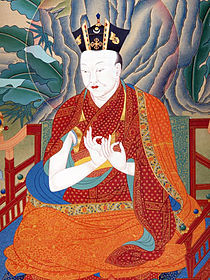 The life of Choying Dorje
The life of Choying Dorje 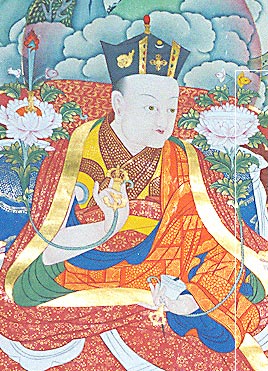 Khakhyab Dorje
Khakhyab Dorje 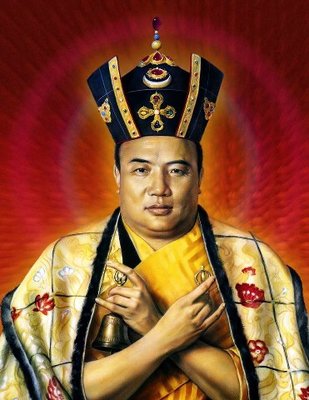 Born into a noble family in 1923, Rangjung Rigpe Dorje
Born into a noble family in 1923, Rangjung Rigpe Dorje 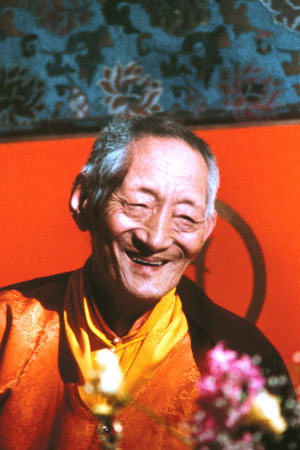 In accordance with tradition, Karmapa oversaw the education of his four young regents: Shamar Rinpoche; Tai Situ Rinpoche; Jamgon Kongtrul; and Gyaltsap Rinpoche. Here,to complete our understanding of the relative positions of our own linege masters, we should mention that one of Karmapa's close students was Kalu Rinpoche
In accordance with tradition, Karmapa oversaw the education of his four young regents: Shamar Rinpoche; Tai Situ Rinpoche; Jamgon Kongtrul; and Gyaltsap Rinpoche. Here,to complete our understanding of the relative positions of our own linege masters, we should mention that one of Karmapa's close students was Kalu Rinpoche 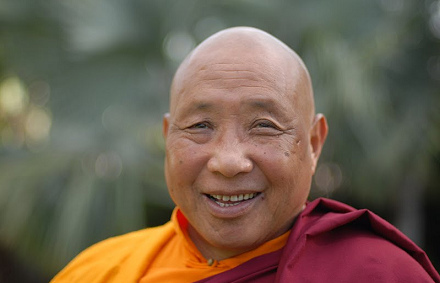 It was during their early years of exile that Lama Norlha
It was during their early years of exile that Lama Norlha 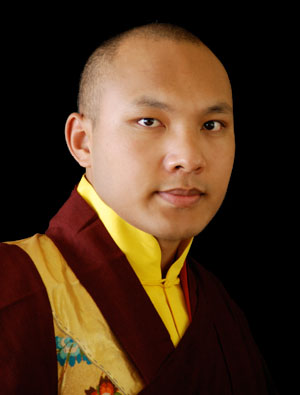 The XVII Karmapa, Urgyen Trinley Dorje
The XVII Karmapa, Urgyen Trinley Dorje